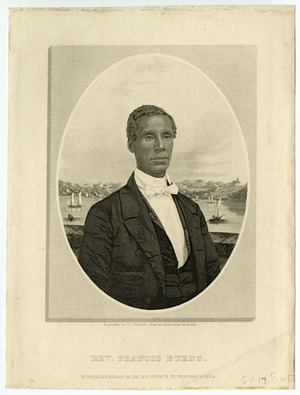Francis Burns (minister) facts for kids
Quick facts for kids
Francis Burns
|
|
|---|---|
 |
|
| Born | 5 December 1809 Albany, New York, US
|
| Died | 18 April 1863 |
| Occupation | Missionary |
| Known for | The first Missionary Bishop, and the first African-American Bishop of the Methodist Episcopal Church (elected in 1858) |
Francis Burns (1809 – 1863) was an American Methodist minister. He served as a missionary in Liberia, a country in West Africa. He made history as the first Missionary Bishop and the first African-American Bishop of the Methodist Episcopal Church. He was elected to this important role in 1858.
Contents
Early Life and Learning
Francis Burns was born on December 5, 1809, in Albany, New York. At that time, New York was still a state where slavery was allowed. His family was very poor.
Facing Challenges as a Youngster
When Francis was just four years old, his parents sent him to work for a farmer. At age eight, he was "indentured" to a Mr. Atwood. This meant he was legally bound to work for Mr. Atwood to learn farming until he turned 21.
Getting an Education
Even though he worked, Francis was allowed to go to school in the winter. This was when farm chores were fewer. Later, because his health wasn't good, he attended school all summer too. He loved learning and tried hard to get as much knowledge as he could.
Becoming a Preacher
The Atwood family, who lived in Ashland, New York, were very religious. Francis attended the North Settlement Methodist Church. Mrs. Atwood, his guardian, was a Methodist "class-leader," a respected church role.
Finding His Calling
At 15, Francis became a Christian. Two years later, at 17, he felt a strong calling from God to preach. However, he couldn't start right away because he was still bound to his master until he was 21.
After his indenture ended, he began holding religious meetings. He also started teaching school. He was even called "the first colored student in a white school" at the Academy in Lexington Heights, New York. He was also known as "the first colored teacher in a white school" in his community. People respected him greatly. He later became a local preacher.
Bishop Matthew Simpson, a leader in the Methodist church, once said about Francis Burns: "Because of his intelligence, his strong faith, and his character, he overcame the challenges of his race. He earned the respect of everyone who knew him."
Missionary Work in Africa
Francis Burns became well-known as a pastor and preacher. A church leader named Dr. Terry helped him consider missionary work. Dr. Terry encouraged him to study so he could be ready to go to Liberia or other places.
Journey to Liberia
In 1834, Francis Burns sailed to Liberia with Rev. John Seys. They arrived in Monrovia on October 18. His first job in Liberia was at Cape Palmas. For two years, he suffered from a serious fever common in the region.
He joined the Liberia Annual Conference in 1838. From 1840 to 1842, he was an assistant preacher on the Bassa Circuit. He then served in Monrovia from 1843 to 1844.
Hard Work and Leadership
Ten years after arriving in Liberia, Francis Burns returned to New York. There, he was ordained as a minister by Bishop Janes. He worked very hard as a missionary. He also taught at the Monrovia Seminary and was the editor of a newspaper called Africa's Luminary. He did all these jobs with great skill.
Becoming a Bishop
In 1849, the church's work in Liberia was divided into districts. Rev. Burns was chosen as the Presiding Elder of the Cape Palmas District. This meant he was in charge of several churches in that area. For six years, he also served as the President of the Conference. He clearly reported on the mission's progress to the Missionary Board in New York. In 1851, he also helped open an academy in Monrovia.
A Historic Election
In 1856, the Methodist Episcopal Church decided to elect a Missionary Bishop specifically for their work in Africa. In January 1858, the Liberia Annual Conference elected Rev. Francis Burns as their first Bishop. This was a huge step, making him the first African-American Bishop in the Methodist Episcopal Church.
He traveled back to the U.S. for his "consecration," which is a special ceremony to officially make someone a bishop. This happened on October 14, 1858, in Perry, Wyoming County, New York. Bishops Janes and Baker led the ceremony.
Bishop Simpson, quoting someone who was there, described the event: "Even though he had dark skin, he had won the hearts and respect of everyone who met him. His manner is very pleasant, and his spirit is kind and good. He seems to have all the qualities of a gentleman and a Christian minister. He also has an intelligent and educated mind, speaks easily and well, and is a perfect example of an African leader."
Bishop Burns returned to Africa right after his consecration. He dedicated himself to his new role for almost five more years.
Later Life and Legacy
Bishop Burns' health began to get worse. His doctor advised him to take a sea voyage and return to the U.S.A. Sadly, he died on April 18, 1863, just three days after arriving in Baltimore, Maryland. This was only three months after the Emancipation Proclamation was issued in the United States, which declared many enslaved people free. Bishop Burns was buried in Palm Grove Cemetery in Monrovia, Liberia.
See also
- List of bishops of the United Methodist Church

